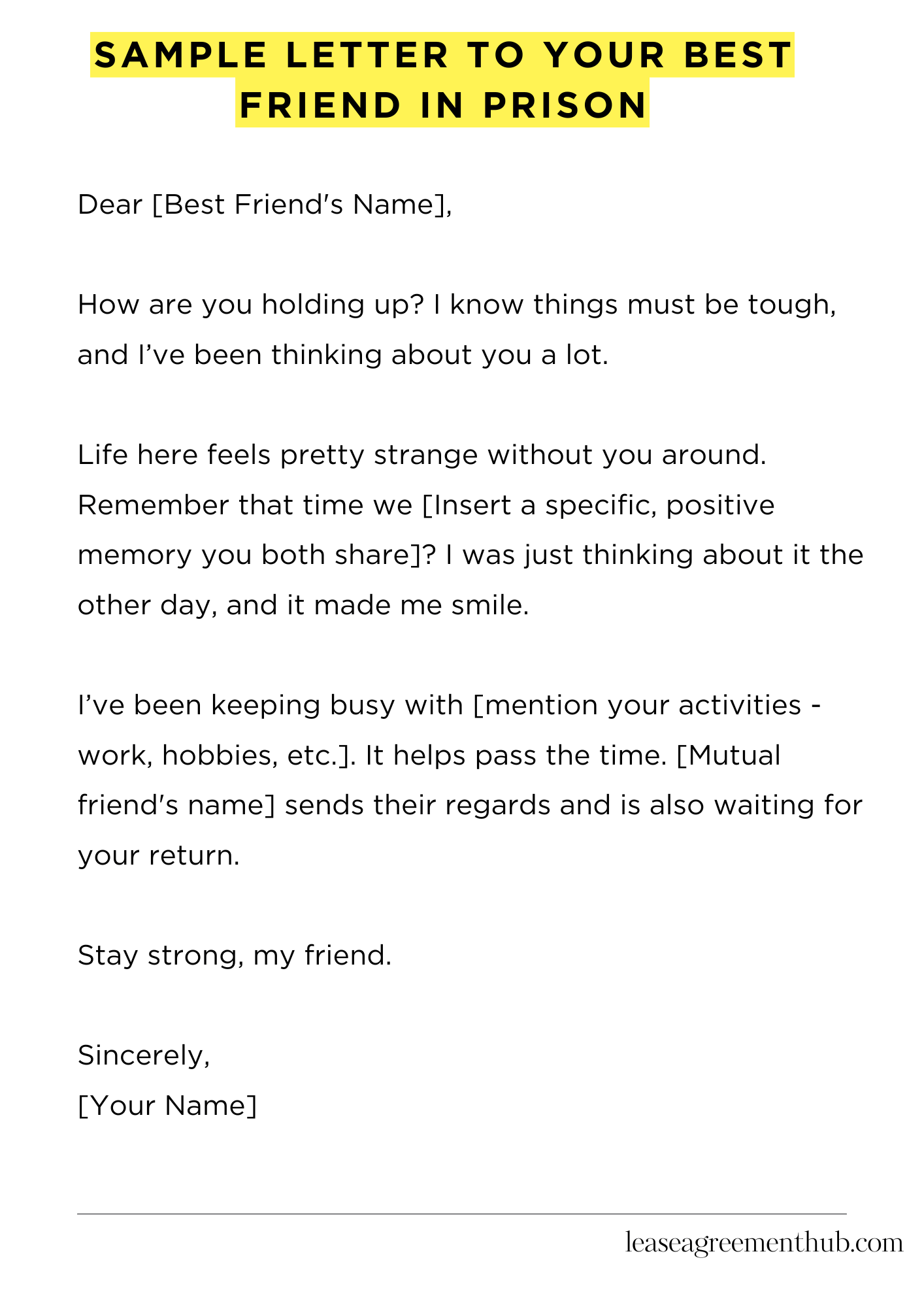A “Sample Letter To Your Best Friend In Prison” is a template. It helps you write to your incarcerated best friend. You might need it to offer support. It shows you care during a tough time.
We know writing can be hard. Especially under these circumstances. That’s why we’ve gathered samples. These examples will make it easier. You can express your feelings clearly.
Consider this your go-to resource. Find inspiration and practical guidance here. Let’s craft a meaningful letter together. It can bring comfort to your friend.
Sample Letter To Your Best Friend In Prison
[Your Name]
[Your Address]
[City, State, Zip Code]
[Date]
[Inmate’s Full Name]
[Inmate’s Identification Number]
[Prison Address]
[City, State, Zip Code]
Dear [Best Friend’s Name],
How are you holding up? I know things must be tough, and I’ve been thinking about you a lot.
Life here feels pretty strange without you around. Remember that time we [Insert a specific, positive memory you both share]? I was just thinking about it the other day, and it made me smile.
I’ve been keeping busy with [mention your activities – work, hobbies, etc.]. It helps pass the time. [Mutual friend’s name] sends their regards and is also waiting for your return.
Don’t worry about things here. We’re all doing our best to keep things running smoothly until you get back.
Write back when you can. Hearing from you would mean a lot.
Stay strong, my friend.
Sincerely,
[Your Name]

How to Write Letter To Your Best Friend In Prison
Subject Line: A Glimmer of Hope
- Keep it succinct. A few words that signal positivity can make a world of difference.
- Examples: “Thinking of you,” “Catching up,” or “News from the outside.” Avoid anything too emotionally charged, as prison staff often scrutinize correspondence.
Salutation: Reaffirming Your Bond
- Start with a warm, familiar greeting. Opt for “My Dearest [Name]” or a simple “[Name],” depending on your rapport.
- Avoid overly effusive language that might raise eyebrows during censorship.
Opening Paragraph: Setting the Stage
- Begin with a brief update about yourself or a shared memory.
- Mention something mundane, like the weather or a local event. This helps normalize the interaction and reminds them of the world outside.
- Example: “The tulips are in full bloom this year, just like when we planted them that one spring…”
Body: Weaving a Tapestry of Normality
- Share news, but avoid anything that could incite anxiety or despair. Keep it light.
- Discuss hobbies, books, movies, or music. Engage their mind and offer a momentary escape.
- Incorporate anecdotes. A funny story or a heartwarming memory can be incredibly uplifting.
- Refrain from gossiping or divulging sensitive information about others.
- Ask open-ended questions to encourage a response and maintain the dialogue.
Addressing Their Situation: A Delicate Dance
- Acknowledge their circumstances with empathy, but avoid dwelling on the negative.
- Offer words of encouragement and unwavering support.
- Remind them of their strengths and resilience.
- Steer clear of legal advice or promises you cannot keep.
- Example: “I know this is a trying time, but I have faith in your fortitude…”
Practical Matters: Keeping it Real
- Inquire about their needs. Is there anything you can send them (within regulations, of course)?
- Offer to be a conduit for communication with family members.
- Be mindful of prison regulations regarding permissible items and content.
- Always include your return address clearly.
Closing: A Fond Farewell
- End with a heartfelt closing. “With unwavering affection,” “Thinking of you always,” or “Yours eternally” are all fitting options.
- Reiterate your commitment to their well-being.
- Sign off with your name or a cherished nickname.
- Example: “Stay strong, my friend. Until next time…”
Frequently Asked Questions: Writing to Your Best Friend in Prison
Writing letters to incarcerated friends can provide much-needed support during a difficult time. This FAQ addresses common questions regarding the content and practical aspects of corresponding with a friend in prison.
What should I write about in my letter?
Focus on positive updates about your life, shared memories, and news from mutual friends. Avoid discussing sensitive topics related to their case or prison environment.
Are there any topics I should avoid?
Refrain from discussing illegal activities, explicit content, or gossip. Be mindful of prison regulations and avoid anything that could be misinterpreted as threatening or harmful.
How often should I write?
Write as often as you feel comfortable, but be consistent. Regular correspondence can provide a sense of normalcy and connection for your friend.
What is the proper way to address the envelope?
Use the inmate’s full name, inmate identification number, and the complete address of the correctional facility. Check the facility’s website for specific mailing guidelines.
Can I send photos or other items in my letter?
Most facilities have strict rules regarding what can be sent. Check the prison’s regulations before sending anything other than letters to avoid having your correspondence rejected.
Related: